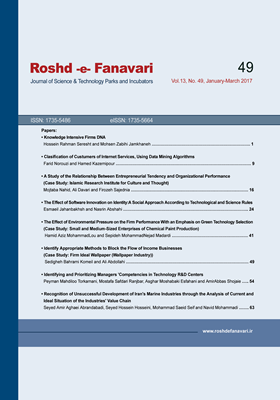ارتباط گرایش کارآفرینانه بر عملکرد سازماني (مطالعه موردی: پژوهشگاه فرهنگ و اندیشه اسلامی)
الموضوعات : Entrepreneurship and Mnagement of Knowledge-based Firms
مجتبي ناهيد
1
![]() ,
علی داوری
2
,
فيروزه ساجدنيا
3
,
علی داوری
2
,
فيروزه ساجدنيا
3
1 - دانشگاه قزوین
2 - دانشگاه تهران
3 - دانشگاه تهران
الکلمات المفتاحية: گرایش کارآفرینانه ابعاد گرایش کارآفرینانه عملکرد سازمان پژوهشگاه فرهنگ و اندیشه اسلامی.,
ملخص المقالة :
در عصر حاضر سرعت تغییرات و دگرگونی به حدی است، که هیچ یک از افراد بشر حتی در یکقرن گذشته پیش بینی چنین تغییراتی را نمیکرد. فرآیند کارآفرینی، فرآیندی است كه طی آن در بطن یك جامعه كهن، سامان تازهای ایجاد میشود. یکی از دغدغههای مهمی که سازمانها را مجاب نموده گرايش به سمت فعاليت های کارآفرينانه داشته باشند، بحث بقا و رشد میباشد. در نتیجه بايد اذعان داشت زمان آن فرا رسيده كه به بررسي روابط ميان رفتار كارآفرينانه و عملكرد پرداخته شود. از اين رو هدف این پژوهش بررسی رابطه میان گرایش کارآفرینانه و عملکرد سازمانی پژوهشگاه فرهنگ و اندیشه اسلامی در سال 1394 میباشد. برای این منظور از روش تحقیق توصیفی و از نوع همبستگی برای بررسی روابط میان متغیرها استفاده شده و جامعه آماری تحقیق برخی کارکنان برحسب سطوح مختلف مدیریتی و اعضای هیات علمی و كارشناسان که 110 نفر از 320 نفر كل کارکنان برآورد گرديد. براي تحليل دادهها از همبستگي پيرسون و رگرسيون چند متغيره و براي تائید مدل از مدل معادلات ساختاري استفاده شده است. نتایج این تحقیق نشان دهنده وجود رابطه مثبتی میان گرایش کارآفرینانه و عملکرد سازمانی به طور مستقيم و نوآوری، پیشگامی، مخاطرهپذيري و رقابت تهاجمي به عنوان ابعاد گرایش کارآفرینانه بر عملکرد سازماني به طور غیر مستقیم ميباشد، اما میان استقلال طلبي با عملکرد سازمانی رابطه معناداری یافت نشد؛ بنابراین توسعه نگرش و توجه به گرایش کارآفرینانه در سازمان میتواند در افزایش عملکرد سازمانی مؤثر واقع شود.
1- رجبزاده قطري، علي؛ حسنزاده خوشطینت، عليرضا، نالچيگر، نيلوفر و نالچيگر، سروش (1389)، ارائه مدل عوامل مؤثر بر ايجاد ريسك در زنجيره تأمین الكترونيكي و تأثیر آن بر عملكرد سازماني مديريت فناوري اطلاعات، دوره 2، شماره 4، ص 59 - 78.
2- رضوي، سید مصطفی؛ زالي، محمدرضا؛ رشيدي، محمود و ديداري، جاويد (1390)، نقش گرايش کارآفرينانه در عملکرد سازماني؛ شعب بانک ملت شهر تهران، پژوهشنامه مديريت اجرايي، دوره 3، شماره 5، ص 95 – 116.
3- رهنورد، فرجهاله (1387)، عوامل مؤثر بر ارتقای عملکرد سازمانهای بخش دولتی ایران. پژوهشنامه مدیریت، سال هشتم، شماره 4، ص 79.
4- عبدالوهاب، سليمه (1390)، بررسي تأثیر قابليت نوآوري و گرايش کارآفرينانه بر عملکرد شرکتهای بيمه خصوصي در ایران (مطالعه موردي: شرکتهای بيمه خصوصي کارآفرين و پاسارگاد)، پایاننامه کارشناسیارشد دانشکده کارآفرینی دانشگاه تهران.
5- فطرس، محمدحسن و بیگی، تورج (1389)، بررسی تطبیقی اثرات سرمایه فکري بر عملکرد سازمانی صنعت بانکداري ایران در دو بخش دولتی و خصوصی؛ مطالعه موردي: بانکهای شهر تهران، پژوهشنامه مدیریت اجرایی، سال دهم، شماره اول.
6- Brenkert George, G. (2009). Innovation, rule breaking and the ethics of entrepreneurship, Journal of Business Venturing, 24, 448-464.
7- Hill, E. (2003). The Development of an instrument to measure intrapreneurship: Entrepreneurship within the corporate setting, New York: McGraw - Hill Irwin.
8- Zeqiri, I. (2010). A theoretical overview of the interactions between entrepreneurship and strategic management, Munich Personal RePEc Archive (MPRA paper), Online at http://mpra.ub.uni-muenchen.de/21943/, No. 21943, pp. 1-9.
9- Rauch, A., Wiklund, J., Lumpkin, G. T., & Frese, M. (2009). Entrepreneurial Orientation and business performance: Cumulative empirical evidence. Entrepreneurship Theory and Practice. 33(3) , 761-788.
10- Fang, Niu., & zhang, yulian. x .H, )2009(. Acquistition .of resources, formal organization and entrepreneurial orientation of new ventures ,Journal of Chinese entreprenurship, 1(1) , 40-25.
11- wang, Y., & zhang, x. (2009). operationalization of corporate entrepreneurship and its performance implications in china, Journal of chiness entrepreneurship, 1(1) , 8-20.
12- Lumpkin, G. T., & Dess, G. G. (1996). Clarifying the Entrepreneurial Orientation Construct and Linking it to Performance, ACADEMY OF MANAGEMENT REVIEW, 21, 135-172.
13- Avlonitis, G. J., & Salavou, H. E. (2007). Entrepreneurial orientation of SMEs, product innovativeness, and performance, Journal of Business Research, vpl. 60, pp. 566–575.
14- Rhee, J., & et al. (2010). Drivers of innovativeness and performance for innovative SMEs in South Korea: Mediation of learning orientation, Technovation, 30, 65–75.
15- Lee, S. M., Seong-bae, L., & Raghuvar, D. P. (2011). Culture & entrepreneurial orientation: a multicountry study. International Entrepreneurship & Management Journal, 7, 1-15.
16- Ergün Ercan., & et al. (2004) Connecting The Link Between Corporate Entrepreneurship And Innovative Performance, Global Business and Technology Association Annual Conference Proceedings Book, pp. 259-265.
17- Memili Esra., & et al. (2010). The critical path to family firm success through entrepreneurial risk taking and image, Journal of Family Business Strategy, Vol. 1, pp. 200–209.
18- Walter, A. & et al. (2006). The impact of network capabilities and entrepreneurial orientat ion on university spin-off performance, Journal of Business Venturing, Vol. 21, pp. 541– 567.
19- Hughes, M., & Morgan, R. E. (2007). Deconstructing the relationship between entrepreneurial orientation and business performance at the embryonic stage of firm growth, Industrial Marketing Management, 36(5), 651-661.
20- Tat keh, H., & Mai Nguyen. (2007). The Effects Of Entrepreneurial Orientation and Marketing Information On the Performance Of SMEs, Journal of Business Venturing, 592-611.
21- Oswald, J. )2005(. Manufacturing regeneration through corporate, Emerald Group publishing limited, 25(5), 491-511.
22- Aktan, B., & Bulut, C. (2008). Financial Performance Impacts of Corporate Entrepreneurship in Emerging Markets: A Case of Turkey, European Journal of Economics, Finance and Administrative Sciences, Vol. 12, pp. 69-79.
23- Li, Y-H,. Huang, J-W,. & Tsai, M-T. (2009). Entrepreneurial orientation and firm performance: the role of knowledge creation process, Industrial marketing management, Vol.38.
24- Lee, Sang M. & Lim, Seongbae. (2009), Entrepreneurial orientation and the performance of service business, Servise Business, No. 3, pp. 1-13.
25- Tajeddini, K. (2010). Effect of customer orientation and entrepreneurial orientation on innovativeness: Evidence from the hotel industry in Switzerland, Tourism Management, Vol. 31, pp. 221–231.


